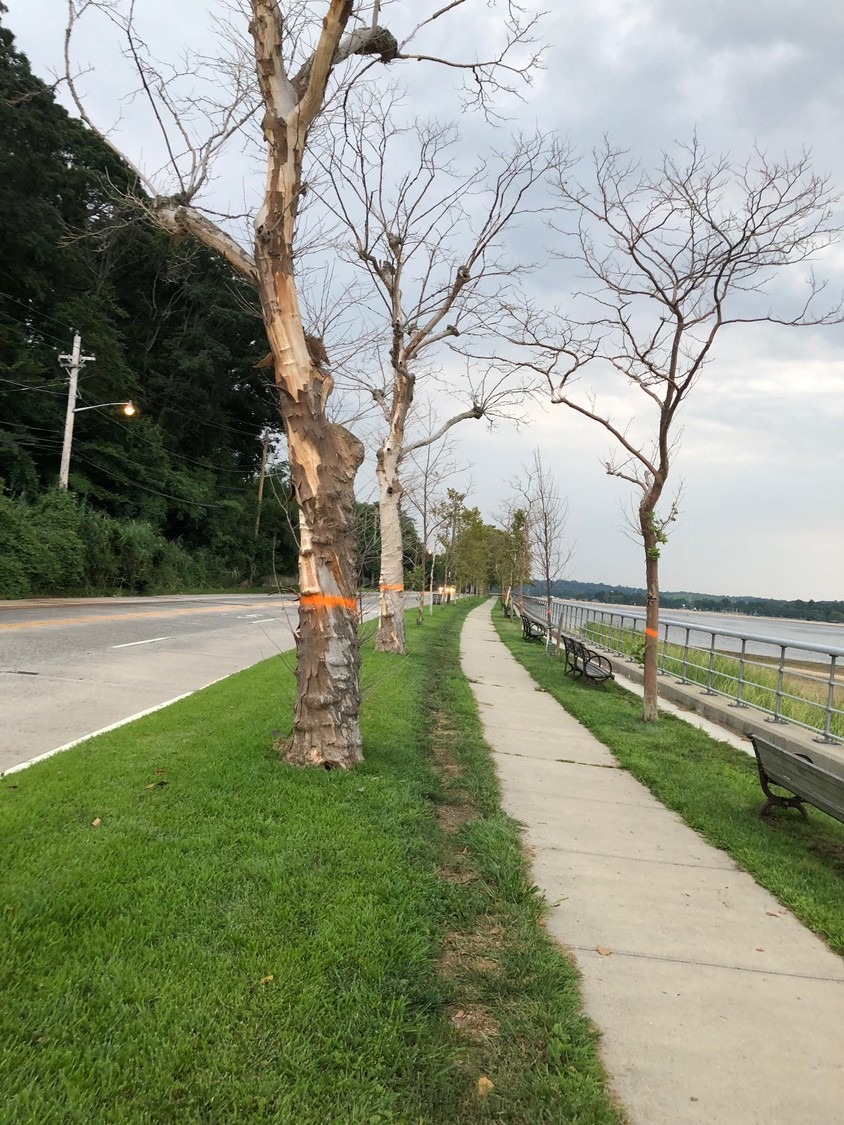Sea Cliff resident speaks for the ailing trees on Prospect
Calls removal, replanting a ‘recurring problem’
In a letter to the editor published earlier this month, Sea Cliff resident Karin Barnaby described 15 ailing trees on Prospect Avenue, which dotted the coastline of Hempstead Harbor, creating a shady canopy a mile long over the esplanade there. Each trunk was marked with orange paint, she noted, a sign that they would eventually be removed.
The maple-like trees — London planes — ranged in diameter from five inches to over a foot, and were planted on the water side of the street.
“Now they are gone,” Barnaby wrote, expressing her frustration with the recurring tree removal and replanting at the same site year after year, with no promise of sustained growth.
“The trees cannot survive in that soil despite extra-tender care, soil management and appropriate pruning,” said Village Administrator Bruce Kennedy, adding that the village is responsible for maintaining the trees. Rising sea levels, coastal flooding and saltwater intrusion, he said, were the seemingly indefatigable culprits.
For the past several years, Kennedy and the Sea Cliff Tree Commission have been working to maintain the health of the trees. The issue, he said, is nothing new. “These trees have been part of the gateway into Sea Cliff for about 80 years,” he said. “There are notes in the board of trustees’ minutes books regarding the health of these trees going back to the 1950s.”
When it investigated, the commission discovered that the trees were being damaged from two sides. Water runoff from higher elevations in the village tends to pool underground near the seawall on Prospect Avenue, leaving the trees there waterlogged. In addition, damage to the seawall — which was last repaired by the county three years ago — has left the esplanade, and the trees that line it, vulnerable to saltwater flooding during storms.
Jane Jackson is the director of stewardship for the North Shore Land Alliance, whose mission is to promote land conservation through acquisition, management and education. She said that the alliance has dealt with a similar problem at a property in Cold Spring Harbor.
“We own one coastal parcel, and we’ve had an issue with storm water runoff there,” Jackson said. “That, combined with recent storm surges, has caused some erosion at the property.”
Saltwater intrusion, she said, is an issue for many coastal communities on the North Shore. “Partly because of climate change and rising sea levels, the saltwater enters into areas where it hadn’t been before,” Jackson said. “It’s a big problem, and it’s not something that is necessarily an easy fix.”
Jackson suggested that a potential solution would be to make improvements to the seawall, which would require action from the county. Nassau County Legislator Delia DeRiggi-Whitton, a Democrat from Glen Cove, said that since funding is limited, the county is restrictive with such projects.
Barnaby suggested more creative solutions to replace the dying trees and solve the problem of saltwater intrusion, recommending the development of a shade-providing waterfront arcade, the installation of artificial trees, or the addition of standing solar panels.
Finding it futile to plant yet another set of London planes, the village will instead plant one or two black tupelo trees, often referred to as black or sour gum trees, at the location. The roots of black tupelos are known for being more tolerant to saltwater.
“These would go on the street side of the sidewalk, away from the seawall,” Kennedy said. “We would monitor these trees over the next few years to see how they survive in that area.”
The black tupelos will be planted along the esplanade next spring.






